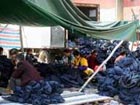| Videos | • Latest |
|
• Feature | • Sports | • Your Videos |
Jeans factories damage local environment

Xintang county in south China's Guangdong Province is the country's jeans production hub. Over 60 percent of jeans sold in China are stitched, sewn and seamed in the county's numerous factories. Though the developing industry has boosted the local economy, it has left a devastating impact on the region's environment.
This river used to provide drinking water for 700,000 Xintang residents. But now, a person's skin will develop ulcers if it comes in contact with the water.
Contamination of the river began in 2003, when the Xinzhou industrial zone, China's largest jeans production base, was built nearby.
Xu Yequan is a local resident. He lives 30 meters from the industrial zone and has witnessed the gradual deterioration of the local environment.
Xu Yequan said, "The air is full of toxic smoke, it smells horrible. As for the river, I used to fish and swim there. But now, all the fish are dead and the water is even more toxic than poison."
Xintang County used to have the most fertile land in Guangdong. But since the emergence of the industrial zone, the land can no longer yield crops.
Xintang resident Xu Peiji said, "The whole county is surrounded by factories. You can't plant anything in the soil and expect it to grow. Rich people have moved away, leaving less fortunate people like me who can do nothing but stay here."
With infertile land crippling the agricultural industry, jeans production has become the backbone of Xintang's economy. Many local residents are employed at the factories. And while they can enjoy earning a better income, they are aware the priceless beauty of their surrounding environment is slipping away.
 0
0 







Go to Forum >>0 Comments